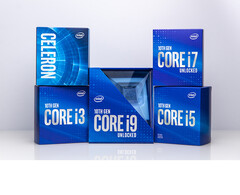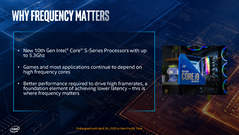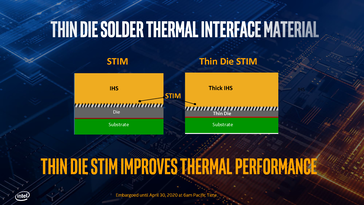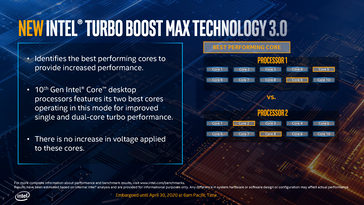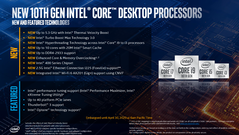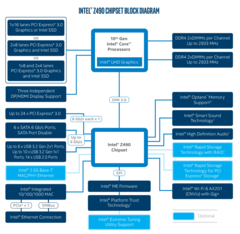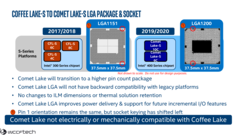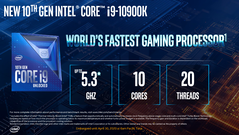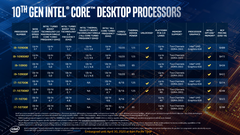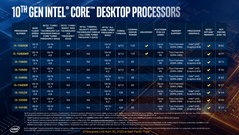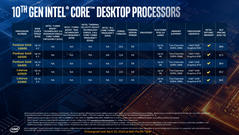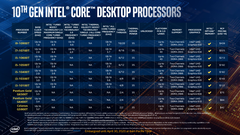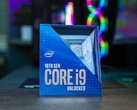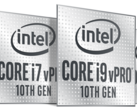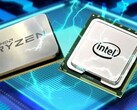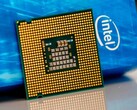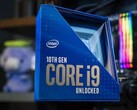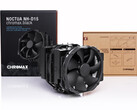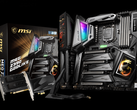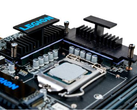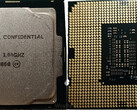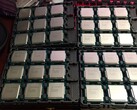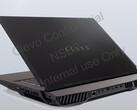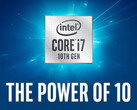After having launched the 10th generation Comet Lake-H (CML-H) series for laptops earlier this month, Intel is now taking wraps off the Comet Lake-S (CML-S) series for desktops. With Comet Lake-S, Intel continues to milk the ageing Skylake architecture to the maximum possible extent. While this has resulted in some neat improvements in single-core boosts, the overall lineup still seems to somewhat fall short of AMD's Ryzen 3000 Zen 2 offerings. We have seen several leaked benchmarks and SKU information about Comet Lake-S in the past, but let's have a look at what Intel has to offer in what could likely be the penultimate 14nm chip for the desktop (assuming Rocket Lake-S will continue to be a 14nm part).
Emphasis on single-core boost
Intel showed that it can break the 5 GHz barrier with the Comet Lake-H lineup and things are no different on the desktop side. Single-core boost performance has always been Intel's forte and the company lays a lot of emphasis on this aspect with the flagship 10-core 20-thread Core i9-10900K that is built to achieve 5.3 GHz under optimal conditions. Intel said that these improvements have enabled it to offer decent performance improvements over the 9th gen when it comes to gaming and content creation. Of course, we will have to test those claims for ourselves later.
Intel also said that it has redesigned the XTU utility to better appeal to overclocking enthusiasts. The new version will offer more control over enabling or disabling hyperthreading on a per core basis, changing the PEG/DMI ratio, and enhanced voltage/frequency curve controls. The ability to change the PEG/DMI ratio directly from within XTU is interesting and offers a more fine-tuned overclock that allows for tuning PCIe lane and memory interface speeds in addition to the BCLK overclock.
Thermal Velocity Boost with a new thin die STIM
Much of what we've learnt about Thermal Velocity Boost (TVB) and Turbo Boost 3.0 in the Comet Lake-H series applies here as well with a few changes. While TVB can allow a 200 MHz boost in the top two cores identified by Turbo Boost 3.0 in the case of CML-H, CML-S gets to have only a 100 MHz benefit. However, TVB in CML-S can work at an operating temperature threshold of up to 70 °C compared to 65 °C in CML-H.
Intel also said that it is making the die thinner while also increasing the thickness of the IHS to allow for better thermal performance. Intel didn't delve much about this in the presentation, but we managed to gather a few details pertaining to the use of soldered thermal interface material (STIM) in CML-S.
The entire 10th generation CML-S lineup is based on two die designs — a 6-core die and a 10-core die. We get to learn that STIM is used only for the SKUs based on the 10-core die. This includes the Core i9, Core i7, and specific Core i5 SKUs such as the Core i5-10600K, Core i5-10600KF, Core i5-10600, and Core i5-10500. Those based on the 6-core die such as the Core i5-10400, Core i5-10400F, and the rest of the lineup continue to use a polymer thermal interface material (PTIM). We do not yet know whether die thinning is implemented in the PTIM SKUs or not.
Platform features
Comet Lake-S offers many of the same platform features found in previous generations. That being said, in true Intel fashion, there is no drop-in support for existing motherboards designed for the 9th generation processors as CML-S requires a higher pin-count LGA 1200 socket which is keyed differently from the previous LGA 1151 socket. This makes LGA 1151 motherboards electrically and mechanically incompatible with CML-S. However, the physical dimensions of the socket remains the same which means current CPU coolers should fit just fine.
Previously, we've reported on the purported high PL1 and PL2 values from a leaked benchmark of the Core i9-10900F. While that benchmark cannot be completely discounted, we do learn that board partners can modify the PL1, PL2, and Tau settings to remain in spec.
Also being indicated is support for Intel I224 Foxville 2.5G Ethernet, support for Wi-Fi AX201, and DDR4-2933 RAM. Similar to CML-H, Intel has not officially validated the use of higher speed memory, but it wouldn't be unusual to see enthusiasts pairing these processors with some of the fastest memory kits on the market.
SKUs and Availability
The 10th gen Comet Lake-S lineup can be broadly divided into four TDP divisions starting from 35 W all the way up to 125 W. The Core i9-10900K is the flagship processor in this lineup. Priced at US$488 RCP, the 10900K is Intel's best bet to take on the AMD Ryzen 9 3900X. There is also a Core i9-10900KF version for those who do not need an iGPU. The non-K versions of the Core i9 and Core i7 are available in a 65 W TDP package. Only the Core i9 SKUs are able to take advantage of TVB.
Interestingly, the Core i5-10600K and Core i5-10600KF are the only 125 W SKUs in the Core i5 series. The rest of the Core i5 and Core i3 chips are all rated at 65 W TDP. Hyperthreading support is present in all Core SKUs.
Intel has also indicated several new Celeron and Pentium Gold SKUs. These are dual-core SKUs with a 58 W TDP and no boost clocks. These chips support AVX2 and AVX instruction sets, but only the Pentiums support hyperthreading.
Finally, the 35 W range is comprised of the T-series processors from the entry-level Celeron G5900T with two cores and two threads to the high-end Core i9-10900T with a 10-core 20-thread configuration. The T-series chips do not support TVB and thus have lower boosts compared to the higher TDP ranges.
10th generation Comet Lake-S processors will be available in retail box packaging and in OEM and system integrator desktops starting May 2020.
Source(s)
Intel Press Brief


 Deutsch
Deutsch English
English Español
Español Français
Français Italiano
Italiano Nederlands
Nederlands Polski
Polski Português
Português Русский
Русский Türkçe
Türkçe Svenska
Svenska Chinese
Chinese Magyar
Magyar